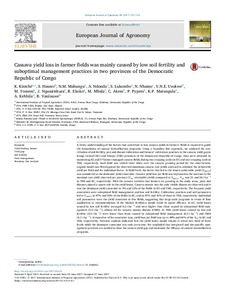| dc.contributor.author | Kintché, K. |
| dc.contributor.author | Hauser, S. |
| dc.contributor.author | Mahungu, N.M. |
| dc.contributor.author | Ndonda, A. |
| dc.contributor.author | Lukombo, S. |
| dc.contributor.author | Nhamo, N. |
| dc.contributor.author | Uzokwe, Veronica N.E. |
| dc.contributor.author | Yomeni, M. |
| dc.contributor.author | Ngamitshara, J. |
| dc.contributor.author | Ekoko, B. |
| dc.contributor.author | Mbala, M. |
| dc.contributor.author | Akem, C. |
| dc.contributor.author | Pypers, Pieter |
| dc.contributor.author | Matungulu, K.P. |
| dc.contributor.author | Kehbila, A. |
| dc.contributor.author | Vanlauwe, Bernard |
| dc.date.accessioned | 2019-12-04T11:08:53Z |
| dc.date.available | 2019-12-04T11:08:53Z |
| dc.date.issued | 2017 |
| dc.identifier.citation | Kintche, K., Hauser, S., Mahungu, N.M., Ndonda, A., Lukombo, S., Nhamo, N. ... & Vanlauwe, B. (2017). Cassava yield loss in farmer fields was mainly caused by low soil fertility and suboptimal management practices in two provinces of the Democratic Republic of Congo. Cassava yield loss in farmer fields was mainly caused by low soil fertility and suboptimal management practices in two provinces of the Democratic Republic of Congo. European Journal of Agronomy, 89, 107-123. |
| dc.identifier.issn | 1161-0301 |
| dc.identifier.uri | https://hdl.handle.net/20.500.12478/1933 |
| dc.description | Article purchased |
| dc.description.abstract | A better understanding of the factors that contribute to low cassava yields in farmers’ fields is required to guide the formulation of cassava intensification programs. Using a boundary line approach, we analysed the contribution of soil fertility, pest and disease infestation and farmers’ cultivation practices to the cassava yield gap in Kongo Central (KC) and Tshopo (TSH) provinces of the Democratic Republic of Congo. Data were obtained by monitoring 42 and 37 farmer-managed cassava fields during two cropping cycles in KC and one cropping cycle in TSH, respectively. Each field was visited three times over the cassava growing period for the observations. Logistic model was fitted against the observed maximum cassava root yields and used to calculate the achievable yield per field and for individual factor. At field level, the factor that led to the lowest achievable yield (Yup(i)1) was considered as the dominant yield constraint. Cassava yield loss per field was expressed as the increase in the maximal root yield observed per province (Yatt- attainable yield) compared to Yup(i)1. Yatt was 21 and 24 t ha−1 in TSH and KC, respectively. With the cassava varieties that farmers are growing in the study areas, pests and diseases played a sparse role in the yield losses. Cassava mosaic was the only visible disease we observed and it was the dominant yield constraint in 3% and 12% of the fields in KC and TSH, respectively. The frequent yield constraints were suboptimal field management and low soil fertility. Cultivation practices and soil parameters led to Yup(i)1 in 47% and 50% of the fields in KC, and in 47% and 41% of those in TSH, respectively. Individual soil parameters were the yield constraint in few fields, suggesting that large-scale programs in terms of lime application or recommendation of the blanket fertilisers would result in sparse efficacy. In KC, yield losses caused by low soil fertility averaged 6.2 t ha−1 and were higher than those caused by suboptimal field management (5.5 t ha−1); almost nil for cassava mosaic disease (CMD). In TSH, yield losses caused by low soil fertility (4.5 t ha−1) were lower than those caused by suboptimal field management (6.5 t ha−1) and CMD (6.1 t ha−1). Irrespective of the constraint type, yield loss per field was up to 48% and 64% of the Yatt in KC and TSH, respectively. Scenario analysis indicated that the yield losses would remain at about two third of these levels while the dominant constraint was only overcome. We concluded that integrated and site-specific management practices are needed to close the cassava yield gap and maximize the efficacy of cassava intensification programs. |
| dc.description.sponsorship | African Development Bank |
| dc.format.extent | 107-123 |
| dc.language.iso | en |
| dc.subject | Yield Factors |
| dc.subject | Yield Gap |
| dc.subject | Soil Fertility |
| dc.subject | Democratic Republic Of The Congo |
| dc.subject | Field Management |
| dc.subject | Boundary Line Analysis |
| dc.title | Cassava yield loss in farmer fields was mainly caused by low soil fertility and suboptimal management practices in two provinces of the Democratic Republic of Congo |
| dc.type | Journal Article |
| dc.description.version | Peer Review |
| cg.contributor.crp | Roots, Tubers and Bananas |
| cg.contributor.affiliation | International Institute of Tropical Agriculture |
| cg.contributor.affiliation | Institut National pour l'Etude et la Recherche Agronomiques, Democratic Republic of Congo |
| cg.contributor.affiliation | Minsitère du Développement Rural, Democratic Republic of Congo |
| cg.coverage.region | Africa |
| cg.coverage.region | Central Africa |
| cg.coverage.country | Congo, Dr |
| cg.isijournal | ISI Journal |
| cg.authorship.types | CGIAR and developing country institute |
| cg.iitasubject | Agronomy |
| cg.iitasubject | Cassava |
| cg.iitasubject | Pests Of Plants |
| cg.iitasubject | Plant Diseases |
| cg.iitasubject | Soil Fertility |
| cg.journal | European Journal of Agronomy |
| cg.howpublished | Formally Published |
| cg.accessibilitystatus | Open Access |
| local.dspaceid | 85144 |
| cg.targetaudience | Scientists |
| cg.identifier.doi | http://dx.doi.org/10.1016/j.eja.2017.06.011 |

